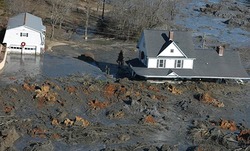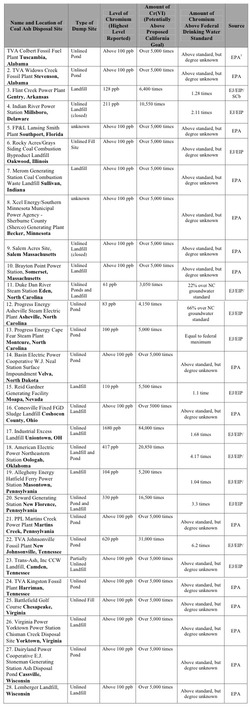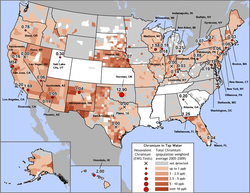Hexavalent chromium pollution linked to coal ash disposal
 The landmark $333 million court settlement that propelled legal researcher Erin Brockovich to environmental stardom involved the contamination of a California town's groundwater with hexavalent chromium, a toxic compound known to cause cancer.
The landmark $333 million court settlement that propelled legal researcher Erin Brockovich to environmental stardom involved the contamination of a California town's groundwater with hexavalent chromium, a toxic compound known to cause cancer.
Now the same dangerous heavy metal, usually associated with steel manufacturing and metal plating, has been discovered seeping from coal ash disposal sites nationwide -- and at levels that far surpass what Brockovich encountered.
"Communities near coal ash sites must add hexavalent chromium to the list of toxic chemicals that threaten their health and families," says Lisa Evans, an attorney with the public interest law firm Earthjustice.
Evans is the author of a report released this week titled "EPA's Blind Spot: Hexavalent Chromium in Coal Ash" [pdf] that was produced with Physicians for Social Responsibility and the Environmental Integrity Project. The federal government does not currently regulate the disposal of coal ash, the toxic waste created by coal-fired power plants that's known to contain potentially dangerous levels of heavy metals, combustion byproducts and radioactive elements. But in the wake of the catastrophic 2008 coal ash spill from a Tennessee Valley Authority power plant in east Tennessee (photo above), the Environmental Protection Agency began crafting rules expected to be released this year.
 The report identifies 28 coal ash dump sites from Massachusetts to Nevada where hexavalent chromium has been detected in the groundwater at levels exceeding federal or state standards. Most of the sites are at power plants, though the list also includes landfills and a golf course in Chesapeake, Va. that was built on coal ash fill. Given the lack of comprehensive federal monitoring requirements for coal ash disposal facilities, the report says that these 28 sites are likely just "the tip of the iceberg."
The report identifies 28 coal ash dump sites from Massachusetts to Nevada where hexavalent chromium has been detected in the groundwater at levels exceeding federal or state standards. Most of the sites are at power plants, though the list also includes landfills and a golf course in Chesapeake, Va. that was built on coal ash fill. Given the lack of comprehensive federal monitoring requirements for coal ash disposal facilities, the report says that these 28 sites are likely just "the tip of the iceberg."
Twelve of the sites are in the South, with North Carolina and Tennessee tied with Pennsylvania for the most with three each. Alabama and Virginia have two apiece, while Arkansas and Florida each have one. The table from the report at right lists all of the sites along with their highest reported levels of chromium (click on image for a larger version).
The report also cites a December 2009 agency study [pdf] on coal ash composition documenting five power plants that produce ash with an especially high potential to release dangerous levels of hexavalent chromium, also known as chromium-6 or Cr(VI). Those plants are DTE Energy's St. Clair plant in East China, Mich.; Progress Energy's Roxboro plant in Semora, N.C.; Southern Co.'s Crist plant in Pensacola, Fla.; TVA's Widows Creek plant in Stevenson, Ala.; and WE Energies Pleasant Prairie plant in Kenosha, Wis.
The very highest level of hexavalent chromium -- 7,370 parts per billion -- leached from the coal ash produced at TVA's Widows Creek facility, where a 2009 spill released some 10,000 gallons of coal ash waste into the Tennessee River. That level is more than 73 times the federal drinking water standard of 100 ppb for total chromium.
To put that in perspective, the average levels of hexavalent chromium contamination Brockovich was dealing with in Hinkley, Calif. were 1.19 ppb, with a peak of about 3 ppb.
 Don't drink the chromium
Don't drink the chromium
While it's long been known that inhaling hexavalent chromium causes lung cancer and other health problems, new information is emerging about the dangers of drinking the chemical -- and just how ubiquitous it is in water supplies:
* Last September, EPA released a draft toxicological review that found hexavalent chromium in tap water is "likely to be carcinogenic to humans."
* In December 2010, after completing an in-depth, peer-reviewed study on hexavalent chromium's oral toxicity, California environmental health officials proposed establishing a public health goal for the chemical's presence in drinking water of just 0.02 parts per billion -- 5,000 times lower than the current federal drinking water standard for total chromium.
* That same month, the nonprofit Environmental Working Group released a report documenting the presence of hexavalent chromium in tap water in 31 of 35 U.S. cities where it conducted tests (click on map above for a larger version). In 25 of those cities -- including Atlanta, Louisville, Ky. and Tallahassee, Fla. -- the levels of the chemical in tap water exceeded the California recommendations.
Two days after the release of the EWG report, the EPA announced that it would work with local and state officials to better understand how widespread the chromium contamination problem is. It also pledged to issue guidance to help water systems develop monitoring and sampling programs for hexavalent chromium.
"EPA takes this matter seriously and we will continue to do all that we can, using good science and the law, to protect people's health and our environment," Administrator Lisa Jackson said at the time.
But as the new report from Earthjustice et al. points out, the agency's coal ash rulemaking has so far ignored the documented cancer threat from hexavalent chromium seeping into groundwater. In calculating the health risks of coal ash, EPA treated chromium as a carcinogen by inhalation only, classifying it as a non-carcinogen when it came to ingestion. In fact, EPA did not mention the cancer risk of ingested hexavalent chromium once in its recent 400-page human and ecological risk assessment [pdf] for coal ash.
The report calls on EPA officials to open their eyes to the full risk of hexavalent chromium -- and to adopt the stricter of the two regulatory approaches it's considering in order to adequately protect people from coal ash pollution.
"The cancer risk from hexavalent chromium is one more serious threat to health from coal ash," says Barbara Gottlieb with Physicians for Social Responsibility. "To protect the public from carcinogens and other dangerous substances, the EPA needs to regulate coal ash as a hazardous waste."
Tags
Sue Sturgis
Sue is the former editorial director of Facing South and the Institute for Southern Studies.
